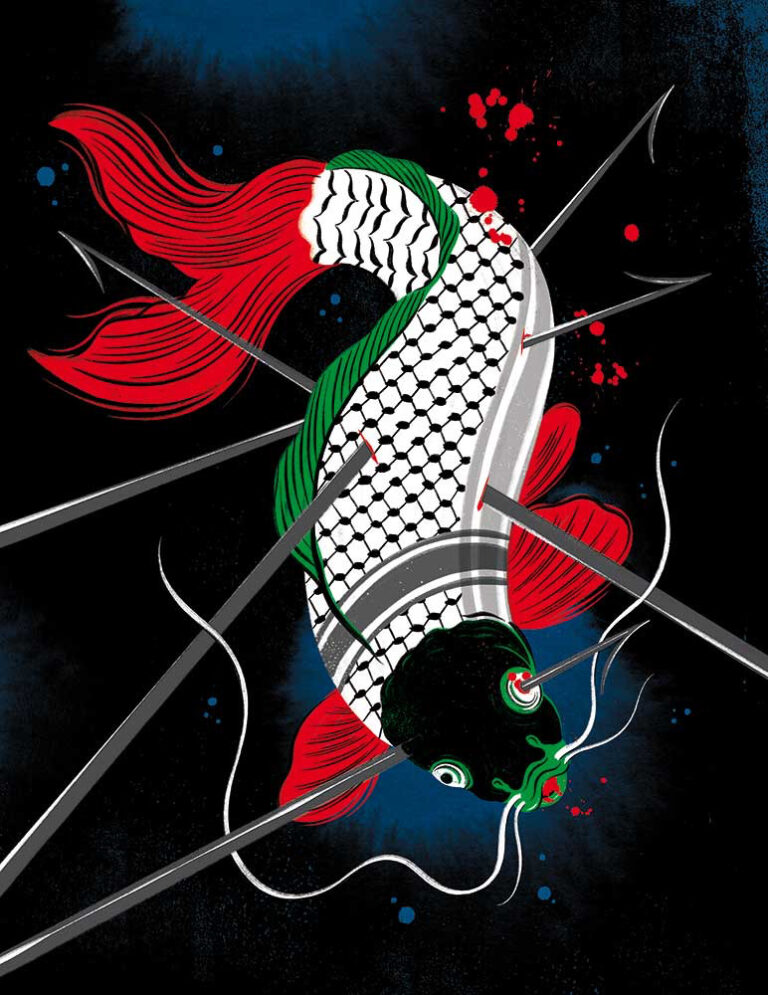…this is for fighting, this is for fun.
This is an article about the recent massacre of six Sikh Americans by a white supremacist US Army veteran, but I begin with this, a United States Marine Corps chant to remind new recruits in boot camp that their weapon was not just a GUN, but more importantly a RIFLE. Military types and weapons specialists care about these distinctions. Stanley Kubrick satirized the unconscious psychosexual energies behind wielding a gun in Full Metal Jacket, when Marine recruits parade with their weapons doing this chant of “This is my rifle, this is my gun, this is for fighting, this is for fun.” They seize their crotches at “gun” and “fun.” When I showed it to my students, some were puzzled at how to interpret this moment that seems so clear to me. The rifle is a phallus, an extension of the rock-hard cock, and in Kubrick’s film, the narrative is completed in the battle for Hue, when a female sniper castrates the Marine squad by killing a few. She herself is surrounded and killed by the surviving Marines in a moment that the critic Susan Jeffords, in The Remasculinization of America: Gender and the Vietnam War, calls a symbolic gang rape. The fact that the killing and the rape are not just about gender and sexuality but race and nation is fairly obvious.
Why am I thinking of this? Because just when I thought I had gotten some anger out of myself, there are now more things to get me angry. The Batman massacre in Aurora, Colorado, which happened the night before I saw The Dark Knight Rises (my tickets bought in advance). Then the massacre of Sikh people in Oak Creek, Wisconsin, yesterday of the day I am writing this, when an Army veteran and white supremacist invaded a temple and killed six before being killed himself. This is not a post about gun control, as I am sure my position on gun control is evident, and nothing I say will change any minds. This is instead about pointing to the direct line from the core of American culture and history to the Viet Nam War to the Oak Creek massacre and a couple of other massacres many of us have already forgotten about.
First: Americans conquer people, okay? For the obvious reasons of territory, resources, and power, but for the more controversial reasons of culture, hate, and psyche. Richard Slotkin argues that American culture and masculinity are built on the need for “regeneration through violence,” which means that American men see mastering violence as a necessary test of their masculinity and, eventually, patriotism. They master violence in using it against the frontier, the wilderness, and its inhabitants, the others to (American) civilization. Eventually (and here this is my argument and that of many others) that frontier crosses the Pacific to the Philippines and Asia, culminating in the Viet Nam War. In the American confrontation with Asia, “Orientalism” merges with regeneration through violence, meaning that American soldiers use their violence and prove their heterosexual manhood by killing, raping, and conquering Orientals. In the US, when we say “Oriental” and the “Orient,” we think of East and Southeast Asia, but when Edward Said wrote Orientalism, he was discussing French and British Orientalism, which defined the Orient as the Near and Middle East. So the massacre of Sikhs in Wisconsin by a white veteran supremacist is only the culmination of a complex history of Orientalism that has been blended with American historical and cultural urges towards white supremacy.
Another direct expression of homicidal American Orientalism was the 1989 Stockton, California, massacre of four Cambodian children and one Vietnamese child in an elementary schoolyard, committed by one Patrick Purdy. In looking for some online information about this massacre, which happened when I was in college near Stockton, I discovered that the first hit for the keywords Stockton, massacre, Patrick Purdy is a site called Murderpedia.org. I’m glad we have enough murders to require an encyclopedia. Here are some tidbits:
“Patrick Purdy, a disturbed drifter and former Stockton resident, opened fire on the school playground with a Chinese-made Type 56 semi-automatic rifle, killing five children and wounding twenty-nine others and a teacher…. Four of the dead children were Cambodian, one was Vietnamese. Most were born in Thailand in refugee camps as their parents fled the genocidal regime of Cambodian ruler Pol Pot and the Khmer Rouge.”
Here are their names: Raphanar Or, Ran Chun, Sokhim An, Oeun Lim and Thuy Tran. Who remembers them now?
But that was 1989. That is ancient history. Most of my students were not even born in 1989. Then what about Jiverly Wong, aka Jiverly Voong? Who remembers him? And his infamous feat happened in 2009. As it happens, Murderpedia.org does remember. Here are some tidbits:
“The perpetrator…was 41-year-old Jiverly Antares Wong (December 8, 1967 – April 3, 2009), a resident of Johnson City, New York. Wong was born into an ethnic Chinese (Hoa) family in South Vietnam. He first came to New York in the late 1980s before moving to California…Several sources suggested possible motivations for Wong’s actions, including feelings of being “degraded and disrespected” for his poor English language ability, frustration over losing his job, and difficulty in finding work in New York. Wong had also allegedly made comments such as “America sucks” and talked about assassinating the president, to his former co-workers at Shop Vac…The Binghamton shootings took place on Friday, April 3, 2009, at the American Civic Association immigration center in Binghamton, New York, United States. At approximately 10:30 a.m. EDT, a naturalized immigrant Jiverly Antares Wong (aka Jiverly Voong) entered the facility and shot numerous people inside. Fourteen people were ultimately confirmed dead, including the shooter, and four were wounded in the incident.”
Here is a list of the dead:
- Parveen Ali, age 26, a migrant from northern Pakistan
- Almir Olimpio Alves, age 43, a Brazilian Ph.D. in Mathematics and visiting scholar at SUNY Binghamton, attending English classes at the Civic Association
- Marc Henry Bernard, age 44, a migrant from Haiti
- Maria Sonia Bernard, age 46, a migrant from Haiti
- Li Guo, age 47, a visiting scholar from China
- Lan Ho, age 39, a migrant from Vietnam
- Layla Khalil, age 53, an Iraqi mother of three children
- Roberta King, age 72, an English language teacher who was substituting for a vacationing teacher
- Jiang Ling, age 22, a migrant from China
- Hong Xiu “Amy” Mao Marsland, age 35, a nail technician who migrated from China in 2006
- Dolores Yigal, age 53, a recent immigrant from the Philippines
- Maria Zobniw, age 60, a part-time case worker at the Civic Association, originally from Ukraine
So here is a case of what Malcolm X calls the chickens coming home to roost. He was talking about the assassination of John F. Kennedy in 1963, and for anyone who follows Vietnamese history, the particular chicken returning to the coop was the assassination of South Vietnamese president Ngo Dinh Diem just a few months earlier, authorized by Kennedy. Malcolm X took a certain pleasure in making his pronouncement, but the problem with chickens coming home to roost is that chickens are not particularly intelligent animals (are they?). To press the metaphor, they’re not homing pigeons. They’re not precise. They can come to roost in your backyard as well as anyone else’s. So Jiverly Wong is an example of this, a hybrid product of American adventurism in Asia combined with an assimilation into an American culture predicated on the necessity of violence, particularly against foreign others, either outside the country or inside. So we have the obvious irony: a racialized immigrant killing other racialized immigrants, expressing all kinds of psychic contradictions and complications. I am not arguing that this explains everything about Jiverly Wong, or any mass killer. Perhaps he was ill. I’ve seen enough mental illness to know that we do not deal with it adequately in American culture. Who knows what else was going on in Wong’s mind, or Purdy’s? But even insane people pick their targets for a reason. Perhaps one motivation for Jiverly Wong was to express his rage at the very (im)possibility of Americanization and those who would aspire to the thing that he could not obtain, except by picking up a gun and killing a lot of innocent people.
What is more frightening than insane people are sane people who kill people. Isn’t that why the first reflex that many have on hearing of mass murders is to describe the perpetrators as insane? Au contraire. I speculate that many of them are quite sane, and it is their rationality that is truly terrifying, the consequence of centuries of European-American history and the intersection with Asians, Orientals, immigrants, others. The Wisconsin shooter may or may not have been insane, but he was the product of a rational American culture that prioritized the necessity of violence, guns, and using them. Mass murder in the end is always both irrational and rational. Irrational, because things have gotten out of control and can backfire, but rational, because the act is a historically specific expression of an entire culture and system. So the Holocaust was not just some aberration of insane people; it was the irrational expression of rational thinking taken to the extreme. So the American culture of mass murder, overseas and domestically, is not an aberration, and its incidents are not to be regarded with the astonishment that is always paraded: it couldn’t happen here, he was the nicest guy, and so on. The fact of the matter is that nice guys commit murder all the time. Sometimes it is as an individual massacring American civilians. Other times it is as a US soldier in an American military whose entire training apparatus since World War II has been scientifically tuned and dedicated to turning nice, average American boys into killers.
This Army veteran, the Wisconsin shooter, was probably a nice, average American boy at some time. Now he will be held up by the press and the politicians as an example not of regenerative violence but of degenerative violence. Still, I am sure there will be some out there who will see him as an example of necessary regeneration, the purging of nonwhite, non-Christian elements from a supposedly white and Christian country. Jiverly Wong, however, will never be a candidate for such martyrdom. He, like most men of color who exercise violence outside of the law, will always be an example of degenerative violence.
I have no desire to change that mythology, to argue that equality in this country will have to come from the barrels of guns wielded by heroic men of color. I write this only to say that the pressures of Americanization are exerted on both white people and people of color. “This is my rifle, this is my gun, this is for fighting, this is for fun,” is a chant not only done by young white men in boot camp, and not only by young white men who fantasize about being in boot camp, but also by men of color. Some of them have learned that one of the fastest ways to prove their manhood and their American selves is to shoot a gun, not at white people, but at people who look like themselves.
_____
“This Is My Rifle, This Is My Gun” was originally published on DiaCritics.org on August 7, 2012.



